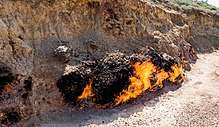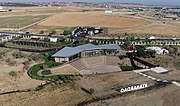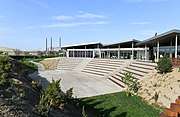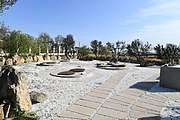Yanar Dag
Yanar Dag (Azerbaijani: Yanar Dağ, meaning "burning mountain") is a natural gas fire which blazes continuously on a hillside on the Absheron Peninsula on the Caspian Sea near Baku, the capital of Azerbaijan (a country which itself is known as "the Land of Fire"). Flames jet into the air 3 metres (9.8 ft) from a thin, porous sandstone layer.[1][2] Administratively, Yanar Dag belongs to Absheron District of Azerbaijan.
Yanar Dag | |
|---|---|
Yanar Dag at night | |
 Yanar Dag | |
| Coordinates: 40°30′6.6″N 49°53′28.51″E | |
| Country | |
Unlike mud volcanoes, the Yanar Dag flame burns fairly steadily, as it involves a steady seep of gas from the subsurface. It is claimed that the Yanar Dag flame was only noted when accidentally lit by a shepherd in the 1950s.[3] There is no seepage of mud or liquid, which distinguishes it from the nearby mud volcanoes of Lökbatan or Gobustan.
On the territory of Yanar Dag, State Historical-Cultural and Natural Reserve was established by the Presidential decree dated 2 May 2007 which operates under the control of State Tourism Agency of Azerbaijan. After major overhaul between 2017-2019, Yanardag Museum and Yanardag Cromlech Stone Exhibition were launched in the area of the Reserve.[4][5]
In the first millennium BCE, the fire played a role in the Zoroastrian religion, as the link between humans and the supernatural spheres.[6]
Geography

The Yanar Dag fire is never extinguished. Around this open fireplace the atmosphere is filled with the smell of gas. The flames emanate from vents in sandstone formations and rise to a height of 10 metres (33 ft) (different figures are mentioned in other references) at the base of a 10-metre-wide (33 ft) scarp below a hillside.[1][7] Yanar Dag is described by the Geological Survey of Azerbaijan as "Intensive flames, to 1 metre (3 ft 3 in) high, develop for 15 metres (49 ft) along the base of a 2–4-metre-high (6.6–13.1 ft) and 200-metre-long (660 ft) tectonic scarp."[8] The surface flames result from the steady gas emissions from underlying soils.[7][8][9][10]
Even the surface of streams near Yanar Dag fire can be ignited with a match. These streams, which otherwise appear calm, are known as Yanar Bulaq: "burning springs." There are several such springs in the vicinity of the Vilascay River, where the local people take curative baths.[1][11]
Alexandre Dumas, during one of his visits to the area, described a similar fire he saw in the region inside one of the Zoroastrian fire temples built around it. Only a handful of fire mountains exist today in the world, and most are located in Azerbaijan. Due to the large concentration of natural gas under the Absheron Peninsula, natural flames burned there throughout antiquity and were reported on by historical writers such as Marco Polo.[1][11]
Most mud volcanoes are located off the Baku‐Shamakha road, about 40 kilometres (25 mi) from the city.[12][13]
Causes

The reason offered for the Yanar Dag fires is the result of hydrocarbon gases emanating from below the earth's surface. Apart from Yanar Dag, the most famous site of such a fire is the Fire Temple near Baku, off the Greater Caucasus, which is a religious site known as an ateshgah, meaning temple of fire. It has also been inferred that such fires could be the cause for "thermal metamorphism."[14][15]
Like the flames of Yanar Dag, the Ateshgah of Baku's flame was a manifestation of the seepage of natural gas from porous strata, but the natural flow at Ateshgah ceased some time ago and the flames seen there now are fed from a gas main for touristic effect - whereas those at Yanar Dag are still entirely natural.[9]
According to a study carried out by the scientists and geologists of the Geological Survey of Azerbaijan, analyses of four samples taken from Yanar Dag revealed that the area of maximum flux was situated at the upper side of the fault scarp - the very area from which the flames emanate. The value of microseepage recorded was in the range of 103 mg m−2 d−1 at approximately 30 metres (~100 ft) from the fire, on the upper part of the study area. It has been inferred that the degassing area is larger than the measured area, and it is very likely that the microseepage is pervasive along the fault zone. This fault scarp is inferred as a part of the huge Balakhan-Fatmai structure on the Absheron Peninsula.[8]
Yanardag State Historical, Cultural and Natural Reserve
In Mammadli village of Absheron district, Yanardag State Historical-Cultural and Natural Reserve was established by the Presidential decree dated 2 May 2007 in order to protect this monument and develop tourism in this area. The Reserve operates under the control of State Tourism Agency of Azerbaijan. After major overhaul between 2017-2019, Yanardag Museum and Yanardag Cromlech Stone Exhibition were launched in the territory of the Reserve. The reserve covering an area of 64.55 hectares features a 3-zoned museum, a 500-seat amphitheater for outdoor concerts, different exhibitions displaying ancient stones and pieces of craftsmanship used by locals, as well as, tombstones, ancient kurgans, 2 burial grounds with historic graves.[4][5][16]
 Yanardag State Historical, Cultural and Natural Reserve
Yanardag State Historical, Cultural and Natural Reserve Yanardag Reserve
Yanardag Reserve Yanardag Cromlech Stone Exhibition
Yanardag Cromlech Stone Exhibition
See also
| Wikimedia Commons has media related to Yanar Dag. |
References
- Kleveman, Lutz (2003). The new great game: blood and oil in Central Asia. Atlantic Monthly Press. p. 15. ISBN 0-87113-906-5. Retrieved November 21, 2010.
- "Mud Volcanoes: Land of fire". Azerbaijan International. Retrieved November 23, 2010.
- Mark Elliot. "Azerbaijan with Georgia".
- "Azərbaycan Prezidentinin Rəsmi internet səhifəsi - XƏBƏRLƏR » Tədbirlər". president.az (in Azerbaijani). Retrieved 2019-06-29.
- "Decree on the establishment of Yanardag State Historical-Cultural and Natural Reserve". www.e-qanun.az. Retrieved 2019-06-29.
- O'Hare, Maureen (2018-10-31). "The fire that's been burning for 4,000 years". CNN Travel. Retrieved 2019-12-26.
- Reay, David; Smith, Pete; Van Amstel, Andre (2010). Methane and Climate Change. Earthscan. pp. 44–46. ISBN 978-1-84407-823-3. Retrieved November 23, 2010.
- Etiope, G.; Feyzullayev, A.; Baciu, C.L.; Milkov, A.V. (February 2004). "Methane emission from mud volcanoes in eastern Azerbaijan". Geology. 32 (6): 465–468. Bibcode:2004Geo....32..465E. doi:10.1130/G20320.1.
- O'Hare, Maureen (2018-10-31). "Eternal flame: How Azerbaijan became the 'Land of Fire'". CNN Travel. Archived from the original on 2019-07-03. Retrieved 2019-07-03.
- "Țara în care există un foc aprins de acum 4.000 de ani. "Arde și când plouă sau ninge". VIDEO". Stirileprotv.ro. Retrieved 2019-07-03.
- "Sea, mountains and Masalli". Region Plus. Archived from the original on December 20, 2011. Retrieved November 23, 2010.CS1 maint: BOT: original-url status unknown (link)
- "Yanardag fire mountain" (PDF). Tisa.az. Retrieved November 24, 2010.
- "Heydar Aliyev International Airport". World 66. Retrieved November 24, 2010.
- Stracher, Glenn B. (2007). Geology of coal fires: case studies from around the world. Geological Society of America. p. 179. ISBN 978-0-8137-4118-5. Retrieved November 23, 2010.
- "Azerbaijan: Countries". Lycos Home. Archived from the original on July 7, 2007. Retrieved November 23, 2010.
- "About Yanardag". yanardag.az. Retrieved 2019-07-03.